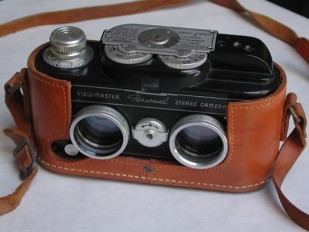Caves, history and invention – story of the View-Master
Posted on: May 11th, 2015 in News & Press |
OTE celebrates new historical marker
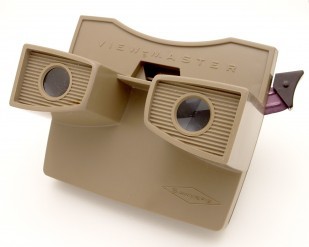 The iconic View-Master’s Oregon roots are now documented on a interpretive historical marker at the Oregon Caves Chateau, located 20 miles off of Hwy 199 in Cave Junction, at 2000 Caves Hwy.
The iconic View-Master’s Oregon roots are now documented on a interpretive historical marker at the Oregon Caves Chateau, located 20 miles off of Hwy 199 in Cave Junction, at 2000 Caves Hwy.
Oregon Travel Experience (OTE) worked with the Illinois Valley Community Development Organization and the National Parks Service to bring this 20th century historic story to light, and to educate Oregonians on the role of the Oregon Caves as a meeting point for two Oregon inventors: William B. Gruber and Harold J. Graves.
“It’s wonderful that the community of Cave Junction and the Oregon Caves are sharing this story with a larger audience,” said OTE’s Oregon Historical Marker Program Administrator Annie von Domitz. “The story of the View-Master’s Oregon origins is a prime example of how our agency helps connect motorists with Oregon attractions that might otherwise be missed.”
“The wo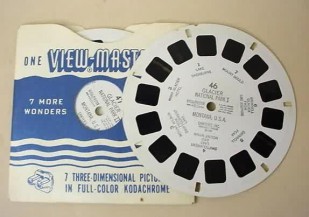 rk performed by OTE’s Historical Marker Program volunteers helps create important connections between travelers and Oregon history. Without historical markers many Oregon stories like the birthplace of the View-Master could remain hidden, even to native Oregonians,” said von Domitz.”
rk performed by OTE’s Historical Marker Program volunteers helps create important connections between travelers and Oregon history. Without historical markers many Oregon stories like the birthplace of the View-Master could remain hidden, even to native Oregonians,” said von Domitz.”
The 2015 unveiling of the new marker was presided over by Oregon Travel Information Council Chair Gwenn Baldwin.
Oregon’s 3D pioneers
An Oregon inventor, William B. Gruber visited the Oregon Caves in 1938. He brought his own unique version of a stereo camera to capture the cavern’s dramatic interior. Gruber’s invention used two Kodak Bantam Specials mounted together on a tripod. His device transcended the Victorian period’s stereoscope and involved machinery that mounted tiny pieces of 16mm Kodachrome color-transparency film onto thick paper reels.
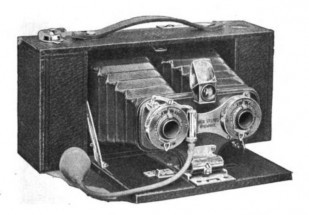 Oregon’s postcard publishing czar, Harold J. Graves, happened to be visiting the caves at the same time as Gruber, and was curious about the inventor’s double camera. That evening over dinner at the Oregon Caves Chateau, the new friends discussed Gruber’s prototype for a 3D reel viewer. From their synchronistic encounter, plans for the View-Master were devised. The device was introduced at the 1939 World’s Fair in New York.
Oregon’s postcard publishing czar, Harold J. Graves, happened to be visiting the caves at the same time as Gruber, and was curious about the inventor’s double camera. That evening over dinner at the Oregon Caves Chateau, the new friends discussed Gruber’s prototype for a 3D reel viewer. From their synchronistic encounter, plans for the View-Master were devised. The device was introduced at the 1939 World’s Fair in New York.
The View-Master was intended as an alternative to scenic postcards and was sold in photography shops, stationary stores, and scenic attraction gift-shops. Produced by Oregon publishing house Sawyer’s Inc., the View-Master was purchased by Mattel Inc. after several decades of Sawyer production.
“Three days of 3D”
The Friends of the Oregon Caves and Chateau headed by Executive Director Sue Densmore, sponsored the three days of activities surrounding the marker dedication.
Speakers, presenters, and Chateau guests mingled with members of Gruber and Graves’ descendants. A special presentation by Rich Dubnow entitled “The History of 3D and the View Master Development” described his time as lead photographer for View-Master and worldwide travels taking images for the popular reels. He is currently owner of Image 3D, in Milwaukee Oregon.
Sterographer Ron Kriesel of the National Stereographic Association and the Cascade Steroscopic Club opened the festivities with a free viewing of a 3D film. Dubnow spoke on the history of 3D, and author Gretchen Gruber Harmon (descendent of William B. Gruber) read from her book “View Master, the Biography of William B. Gruber.”
A brief history of stereo imaging
Since the mid-1800s photography and its accompanying paraphernalia have been revered. From
daguerreotypes to stereoscopic imaging and early silent films, the public was enchanted with photographic entertainment. In particular, three dimensional imaging was wildly popular with Victorian audiences and most middle class parlors contained a device known as a stereoscope – a simple handheld personal projector passed from hand-to-hand.
Duplica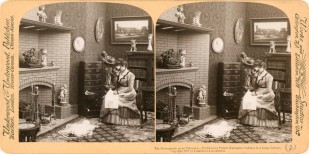 te photos were processed and then pasted onto cardboard “slides” side by side. The collectible slides were then inserted into a holder at the end of the viewer. As viewers peered through the optical lenses, the card would come to life in three dimensions. Subject matter ran the gamut from comic burlesque to world wonders and encyclopedic series. From this low-tech and humble product, the View-Master owes its origins.
te photos were processed and then pasted onto cardboard “slides” side by side. The collectible slides were then inserted into a holder at the end of the viewer. As viewers peered through the optical lenses, the card would come to life in three dimensions. Subject matter ran the gamut from comic burlesque to world wonders and encyclopedic series. From this low-tech and humble product, the View-Master owes its origins.
The latest incarnation of the View-Master interfaces with Google Cardboard (an app for Android devices) and enables users to explore famous places, landmarks, and the natural world in 360-degree “photospheres.” Many of the developers who created the new app played with View-Master toys as children. Mattel has indicated that it will curate and create new experience reels to expand their current content.
 Payments
Payments